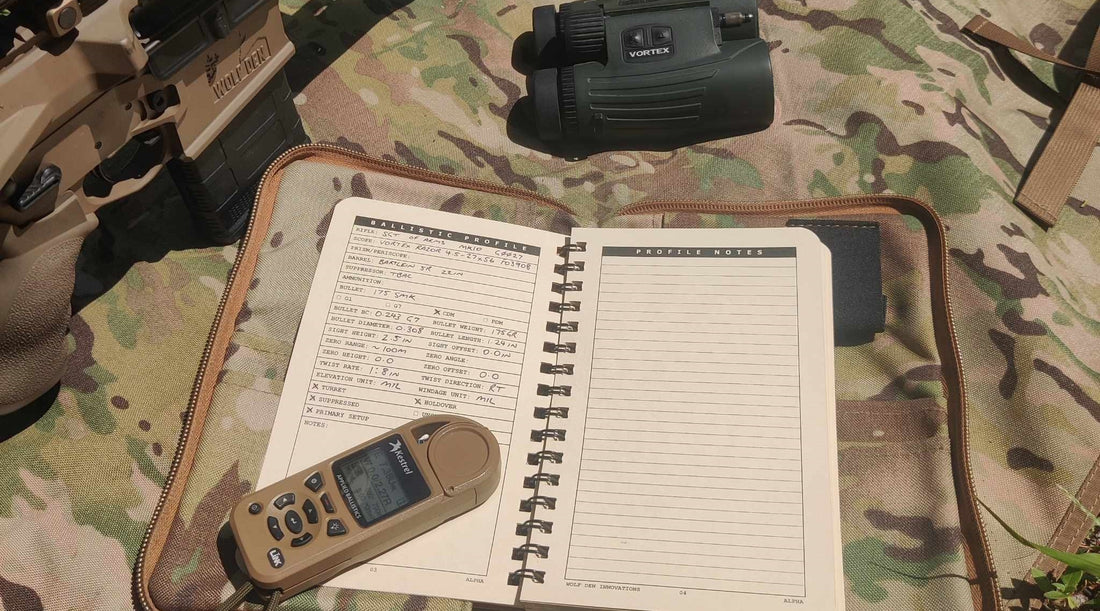Regardless of whether military operations are conventional or unconventional, the role of the sniper within the battlespace has become more critical than ever before. Certain near peer and peer adversary capabilities can be employed to limit the use of technology in the battlespace, and hamper any technological overmatch the force element may have otherwise gained, leading to a need for out of the box solutions when technology fails or is unavailable. Despite this emerging enemy stakeholder threat, snipers continue to fulfil several key roles in the battlespace revolving around information collection and reporting, and engagement of high-value and high priority targets. Often these roles are carried out in complex and challenging terrain. To succeed in these destroy or neutralize missions, snipers need to have access to accurate and up-to-date information about the target and the environment. Even more critical is the need for accurate information relating to the sniper weapon system and ammunition performance. Sniper data books have been a staple in the world of long-range shooting for many decades. These books were typically used to record data on previous engagements (DOPE), usually detailing atmospherics, target range, bullet drop, wind deflection, and spin drift. However, as technology has advanced and the world of shooting has evolved, many argue that these data books are old and outdated and that these types of books can no longer best support the modern sniper.
As commercial ballistic solver software became readily available, the sniper data book slipped out of favor. A significant aspect of delivering surgical precision direct fire onto a target now largely depends on the understanding and use of ballistic solver software. With accurate inputs, a ballistic solver can account for a variety of factors affecting the bullet's trajectory, and then spit out an extremely accurate firing solution for a given engagement scenario. But with so many engagement variables and rounds fired in training, how should a sniper maintain positive control of his ballistic solver inputs to ensure weapon system/ammunition performance and firing solution errors aren’t being overlooked or forgotten? I propose that recording data on ammunition and downrange bullet performance in relation to ballistic solver firing solution accuracy is still a very valuable practice, and that the mighty notebook and pen is still a very valuable tool.
Over the last several years working alongside and training some of the hardest hitters in the US and NATO Special Operations and Conventional sniper communities, I identified the need for an modernized sniper data book. It became very apparent to me that snipers still require a method to record engagement data and ammunition variables, but in a format that can work in partnership with their in-service ballistic solver. A hard-copy weather-resistant book design was ideal to work in tandem with the ballistic solver gun profile and provide a valuable ballistic information recording tool for the sniper. Such a product would have several advantages. Most importantly, it would allow snipers to record firing solution error trends, calibration practices, ammunition temperature sensitivity and muzzle velocity shifts, thereby making it easier to identify issues and remove subtle input errors that affect the accuracy of firing solution predictions downrange. Through data recording, the consistent error trends could be identified and rectified, helping the sniper to calibrate more accurate firing solutions and increase hit probability for any given target engagement scenario. And then there's the other issue a hard-copy notebook would address, the sole reliance on the ballistic solver to safely store your gun profile and calibration data. I can't even begin to describe the number of times I've heard shooters talk about losing their gun profiles after a ballistic solver software update. A close runner up is the number of shooters trying to remember the results of their last few calibrations when they need to isolate and determine the source of some kind of newly discovered firing solution error. You get the point! Write it down on paper that wont go through the washing machine. These experiences ultimately sparked an idea to develop a notebook that could integrate with and support solver software.
I already had previous experience writing, developing, and launching sniper data books. The most recent being the popular Applied Ballistics® Precision Databook, launched in 2018. Since then, I have been hard at work to design and launch a holistic solution to address the need for a modernized sniper data book in the long-range shooting and sniping communities.

The Wolf Den Innovations (WDI) line of Alpha and Beta books provides an innovative design approach that brings the sniper data book into the modern day. Painstakingly developed over the last two years with incredible attention to detail, the WDI Alpha Ballistic Journal is a ballistic notebook, printed on water-resistant Rite in the Rain® paper, and can be used to track the following long-range ballistic information:
- Ballistic gun profile parameters and inputs
- Ammunition performance/consistency parameters
- Sight/scope tracking test results
- Powder temperature and muzzle velocity correlation
- Muzzle velocity shift correlating to barrel round count
- Muzzle velocity and drop calibration results
- Data on previous engagements
- Single and moving target engagements
- Point of impact shift with alternate positions
- Suppressed and unsuppressed point of impact shift
- Cold bore and clean bore point of impact shift
- Suppressed and unsuppressed round count log
- Barrel cleaning log

The Alpha also has a companion guide. The WDI Beta Ballistics Guide is a reference source manual for troubleshooting and practical long-range shooting information. It contains a significant amount of detailed information in the following chapters:

- Weapon/sight setup and marksmanship
- Ammunition componentry and descriptions
- Sighting considerations and scope tracking tests
- Scope cant considerations and calculation procedures
- Ballistic solver features and troubleshooting firing solution errors
- Factors and effects of atmospheric shifts and air density
- Local speed of sound with temperature
- Methods and aids to target ranging
- Wind drift indicators and assessment
- Danger space calculation and employment methods
- Point blank range calculation and employment methods
- High angle target engagement considerations and calculation methods
- Moving target engagement calculations and techniques
- Trajectory clearance of downrange obstacles
- Unit of measure quick conversion factors
- Common target dimensions for standard target types
Either the Alpha or Beta can be employed as a standalone product, although like any sniper team it works best in a pair. Each was designed for use in conjunction with the other. I designed the two as separate products to provide snipers the ability to log ballistic performance information, which can then remain with the weapon system when it’s inevitably reissued to an up-and-coming sniper. Although the weapon changes hands, the new sniper no longer faces the pain and turmoil of establishing the ballistic error trends with that particular weapon, ammunition, and gun profile. The Beta can remain with the sniper or change hands, continuing to be a valuable source of reference information and training material. In this way, the sniper no longer relinquishes anything but the ballistic data, which remains valid for that weapon but is no longer of any use to the previous sniper. This approach provides the incoming weapon user with all the previous data and information conceivably needed to accurately crush targets at range without so many gun profile calibration practices and rounds fired.

I also recognize the need for a data sheet component with the ability to record panoramic and range card sketches, as Multi Target Cards and Range Cards fulfil a critical role for snipers and shooters operating within dynamic target rich environments. To solve this problem, I also designed an updated loose-leaf Rite in the Rain® Multi Target Card and Range Card sheet set, which are available to supplement the Alpha and Beta set of books. The cards provide detailed design layouts for the following uses:
- Panoramic or field sketches
- Atmospheric & gun profile information
- 10x individual targets or target reference points (TRP)
- Target engagement information for each target or TRP designation
- Range Card Sketch
- Elevation, windage, and lead sections for range bands
- Atmospheric and gun profile information
- 4x Target Reference Points
- Environmental and wind condition log
The benefit of loose-leaf Multi Target and Range Card sheets is that the panoramic and range sketches allow a card to be indexed at the front of a data book or OP log cover for quick reference, transferred to another team during a task hand-over-take-over, or even included within a patrol report upon completion of a task. The Multi Target Cards and Range Cards aren't included within the WDI Alpha Ballistics Journal because they fulfil a completely different task and purpose.
Overall, the end product is a set of ballistic journal pages, practical guide information, and dynamic engagement sheets capable of extreme employment flexibility for the end-user, whether the application is sniping, hunting, or long-range shooting. The suite of WDI products are now available via our online store.
The Endstate: Improving hit probability helps to increase the maximum effective engagement range for a given sniper task. This leads to an improved combat survivability rate by increasing the standoff distance between the sniper team and any exposure from accurate enemy fire from the target area. One way to increase hit probability and standoff engagement distances is to improve the accuracy of firing solutions. In part, this is achieved by identification of ballistic error trends and address those issues through various calibration practices. These ballistic errors cannot be easily identified and corrected without some form of information collection and ongoing ballistic data record. Not to mention the amount of match ammunition no longer necessary to calibrate the gun profile each time the weapon changes hands.
In conclusion, a modernized data book designed to integrate with ballistic solvers is a valuable tool for today's precision shooter and sniper. As the role of the sniper continues to evolve within modern conflict and long-range target engagement pushes into extended long-range, the use of a modern data book to isolate ballistic error trends is likely to become even more valuable in the future.
Thanks for reading. If you enjoyed this content, be sure to subscribe, share, and follow us on YouTube, Facebook, and Instagram.

